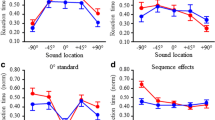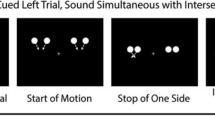Abstract
The goal of the present study was to determine if older adults benefited from attention to a specific sensory modality in a voluntary attention task and evidenced changes in voluntary or involuntary attention when compared to younger adults. Suppressing and enhancing effects of voluntary attention were assessed using two cued forced-choice tasks, one that asked participants to localize and one that asked them to categorize visual and auditory targets. Involuntary attention was assessed using the same tasks, but with no attentional cues. The effects of attention were evaluated using traditional comparisons of means and Cox proportional hazards models. All analyses showed that older adults benefited behaviorally from selective attention in both visual and auditory conditions, including robust suppressive effects of attention. Of note, the performance of the older adults was commensurate with that of younger adults in almost all analyses, suggesting that older adults can successfully engage crossmodal attention processes. Thus, age-related increases in distractibility across sensory modalities are likely due to mechanisms other than deficits in attentional processing.


Similar content being viewed by others
References
Alain C, Woods DL (1999) Age-related changes in processing auditory stimuli during visual attention: evidence for deficits in inhibitory control and sensory memory. Psychol Aging 14:507–519
Alsius A, Navarra J, Campbell R, Soto-Faraco S (2005) Audiovisual integration of speech falters under high attention demands. Curr Biol 15:839–843
Andres P, Parmentier FB, Escera C (2006) The effect of age on involuntary capture of attention by irrelevant sounds: a test of the frontal hypothesis of aging. Neuropsychologia 44:2564–2568
Bahramali H, Gordon E, Lagopoulos J, Lim CL, Li W, Leslie J, Wright J (1999) The effects of age on late components of the ERP and reaction time. Exp Aging Res 25:69–80
Ballesteros S, Reales JM, Mayas J, Heller MA (2008) Selective attention modulates visual and haptic repetition priming: effects in aging and Alzheimer’s disease. Exp Brain Res 189:473–483
Bohn MJ, Babor TF, Kranzler HR (1995) The alcohol use disorders identification test (audit): validation of a screening instrument for use in medical settings. J Stud Alcohol 56:423
Bravo G, Herbert R (1997) Age- and education-specific reference values for the Mini-Mental and Modified Mini-Mental State Examinations derived from a non-demented elderly population. Int J Geriatr Psychiatry 12:1008–1018
Castel AD, Chasteen AL, Scialfa CT, Pratt J (2003) Adult age differences in the time course of inhibition of return. J Gerontol B Psychol Sci Soc Sci 58:P256–P259
Cohen R, Rist F (1992) The modality shift effect. Further explorations at the crossroads. Ann N Y Acad Sci 658:163–181
Corbetta M, Shulman GL (2002) Control of goal-directed and stimulus-driven attention in the brain. Nat Rev Neurosci 3:201–215
Desimone R, Duncan J (1995) Neural mechanisms of selective visual attention. Annu Rev Neurosci 18:193–222
Fabiani M, Low KA, Wee E, Sable JJ, Gratton G (2006) Reduced suppression or labile memory? Mechanisms of inefficient filtering of irrelevant information in older adults. J Cogn Neurosci 18:637–650
Folk CL, Lincourt AE (1996) The effects of age on guided conjunction search. Exp Aging Res 22:99–118
Fox MD, Snyder AZ, Vincent JL, Corbetta M, Van Essen DC, Raichle ME (2005) The human brain is intrinsically organized into dynamic, anticorrelated functional networks. Proc Natl Acad Sci USA 102:9673–9678
Gaeta H, Friedman D, Ritter W, Cheng J (2001) An event-related potential evaluation of involuntary attentional shifts in young and older adults. Psychol Aging 16:55–68
Ghatan PH, Hsieh JC, Petersson KM, Stone-Elander S, Ingvar M (1998) Coexistence of attention-based facilitation and inhibition in the human cortex. Neuroimage 7:23–29
Groth KE, Allen PA (2000) Visual attention and aging. Front Biosci 5:D284–D297
Haringsma R, Engels GI, Beekman AT, Spinhoven P (2004) The criterion validity of the Center for Epidemiological Studies Depression Scale (CES-D) in a sample of self-referred elders with depressive symptomatology. Int J Geriatr Psychiatry 19:558–563
Healey MK, Campbell KL, Hasher L (2008) Cognitive aging and increased distractibility: costs and potential benefits. Prog Brain Res 169:353–363
Hugenschmidt CE, Mozolic JL, Laurienti PJ (2009) Suppression of multisensory integration by modality-specific attention in aging. Neuroreport 20:349–353
Johnson JA, Zatorre RJ (2005) Attention to simultaneous unrelated auditory and visual events: behavioral and neural correlates. Cereb Cortex 15:1609–1620
Kastner S, Ungerleider LG (2000) Mechanisms of visual attention in the human cortex. Annu Rev Neurosci 23:315–341
Kastner S, Ungerleider LG (2001) The neural basis of biased competition in human visual cortex. Neuropsychologia 39:1263–1276
Kawashima R, O’Sullivan BT, Roland PE (1995) Positron-emission tomography studies of cross-modality inhibition in selective attentional tasks: closing the “mind’s eye”. Proc Natl Acad Sci USA 92:5969–5972
Kleinbaum DG (1996) Survival analysis: a self-learning text. Springer, New York
Laurienti PJ, Kraft RA, Maldjian JA, Burdette JH, Wallace MT (2004) Semantic congruence is a critical factor in multisensory behavioral performance. Exp Brain Res 158:405–414
Laurienti PJ, Burdette JH, Maldjian JA, Wallace MT (2006) Enhanced multisensory integration in older adults. Neurobiol Aging 27:1155–1163
Lavie N, Cox S (1997) The efficiency of visual selective attention: efficient visual search leads to inefficient distractor rejection. Psychol Sci 8:395–398
Madden DJ, Langley LK (2003) Age-related changes in selective attention and perceptual load during visual search. Psychol Aging 18:54–67
Madden DJ, Turkington TG, Provenzale JM, Denny LL, Langley LK, Hawk TC, Coleman RE (2002) Aging and attentional guidance during visual search: functional neuroanatomy by positron emission tomography. Psychol Aging 17:24–43
Madden DJ, Whiting WL, Cabeza R, Huettel SA (2004) Age-related preservation of top-down attentional guidance during visual search. Psychol Aging 19:304–309
Maylor EA, Lavie N (1998) The influence of perceptual load on age differences in selective attention. Psychol Aging 13:563–573
McCarley JS, Mounts JR, Kramer AF (2004) Age-related differences in localized attentional interference. Psychol Aging 19:203–210
Mozolic JL, Hugenschmidt CE, Peiffer AM, Laurienti PJ (2008a) Modality-specific selective attention attenuates multisensory integration. Exp Brain Res 184:39–52
Mozolic JL, Joyner D, Hugenschmidt CE, Peiffer AM, Kraft RA, Maldjian JA, Laurienti PJ (2008b) Cross-modal deactivations during modality-specific selective attention. BMC Neurol 8:35
Plude DJ, Enns JT, Brodeur D (1994) The development of selective attention: a life-span overview. Acta Psychol (Amst) 86:227–272
Poliakoff E, Ashworth S, Lowe C, Spence C (2006) Vision and touch in ageing: crossmodal selective attention and visuotactile spatial interactions. Neuropsychologia 44:507–517
Posner MI, Snyder CR, Davidson BJ (1980) Attention and the detection of signals. J Exp Psychol 109:160–174
Roland PE (1982) Cortical regulation of selective attention in man. A regional cerebral blood flow study. J Neurophysiol 48:1059–1078
Rowe G, Valderrama S, Hasher L, Lenartowicz A (2006) Attentional disregulation: a benefit for implicit memory. Psychol Aging 21:826–830
Spence C, Driver J (1997) On measuring selective attention to an expected sensory modality. Percept Psychophys 59:389–403
Spence C, Nicholls ME, Driver J (2001) The cost of expecting events in the wrong sensory modality. Percept Psychophys 63:330–336
Stein BE, Meredith MA (1993) The merging of the senses. MIT Press, Cambridge, MA
Stein BE, Stanford TR (2008) Multisensory integration: current issues from the perspective of the single neuron. Nat Rev Neurosci 9:255–266
Strupp M, Arbusow V, Borges Pereira C, Dieterich M, Brandt T (1999) Subjective straight-ahead during neck muscle vibration: effects of ageing. Neuroreport 10:3191–3194
Tales A, Troscianko T, Wilcock GK, Newton P, Butler SR (2002) Age-related changes in the preattentional detection of visual change. Neuroreport 13:969–972
Talsma D, Woldorff MG (2005) Selective attention and multisensory integration: multiple phases of effects on the evoked brain activity. J Cogn Neurosci 17:1098–1114
Talsma D, Doty TJ, Woldorff MG (2007) Selective attention and audiovisual integration: is attending to both modalities a prerequisite for early integration? Cereb Cortex 17:679–690
Therneau TM, Grambsch PM (2000) Modeling survival data: extending the Cox model. Springer, New York
van Atteveldt NM, Formisano E, Goebel R, Blomert L (2007) Top-down task effects overrule automatic multisensory responses to letter-sound pairs in auditory association cortex. Neuroimage 36:1345–1360
Verhaeghen P, Cerella J (2002) Aging, executive control, and attention: a review of meta-analyses. Neurosci Biobehav Rev 26:849–857
Wenger MJ, Gibson BS (2004) Using hazard functions to assess changes in processing capacity in an attentional cuing paradigm. J Exp Psychol Hum Percept Perform 30:708–719
Yang L, Hasher L (2007) The enhanced effects of pictorial distraction in older adults. J Gerontol B Psychol Sci Soc Sci 62:P230–P233
Acknowledgments
The authors would like to thank Ms. Debra Hege for her invaluable assistance. Research support was provided by NIH#NS042658, the Roena Kulynych Memory and Cognition Research Center, and the Wake Forest University GCRC #RR07122.
Conflict of interest statement
The authors report no actual or potential conflicts of interest relating to this research.
Author information
Authors and Affiliations
Corresponding author
Rights and permissions
About this article
Cite this article
Hugenschmidt, C.E., Peiffer, A.M., McCoy, T.P. et al. Preservation of crossmodal selective attention in healthy aging. Exp Brain Res 198, 273–285 (2009). https://doi.org/10.1007/s00221-009-1816-3
Received:
Accepted:
Published:
Issue Date:
DOI: https://doi.org/10.1007/s00221-009-1816-3




